Review by Pete Vack
Order here:
www.palawan.co.uk
Roy Smith’s latest book made this reviewer think of Roy’s career as a driver/writer/historian. It is more than impressive; we’ve been working with Roy since 2010 or before and as I looked back I was amazed at what he has achieved and what I forgot! Silver Steeds, Roy’s 10th book in 12 years, was published by the strictly upper echelon Palawawn Press, and already has been selected by Classic & Sports Car Magazine as their March 2022 ‘Book of the Month.’
So what is Silver Steeds about? Writes Roy, “It is written to pay homage to the efforts of the Porsche Motor Sport department and to be a tribute – a dedication – to its spectacular, pace-setting early sports racing cars.” And that title – Silver what? “These mainly silver cars, often were called the Spyders,” explains Roy. “They were unsophisticated, sensitive to drive, at a time when motor racing was only for the brave. The cars, our Steeds, were driven in the way of the Teutonic knights of old, also brave men who rode their steeds into the joust in silver armour, evoking a similarity in image. Thus the title Silver Steeds was for me a natural choice.” We might add that a few women also did extremely well driving Porsche racers.
Smith focuses on the years 1948-1965, a period of simplicity between eras of great complexity. The Porsche- Auto Union was a masterpiece of engineering, and the post war design for the Cisitalia Grand Prix car was even more complex, with four wheel drive. After the success of the four cylinder Porsche 904, the flat six, eight and twelves heralded in another complicated, costly era. In between was a sweet spot for Porsche and other companies such as Alfa Romeo as they struggled to grow in a very difficult and cash poor economy. It was simplicity by necessity.

The Type 550 models under construction in the Zuffenhausen Werk 2, circa 1953/early 1954. Huschke von Hanstein (centre right) surveys the production team.
From the outside, the early years at Porsche, with eager, talented, enthusiastic employees hammering together the first Porsche at the sawmill at Gmund, appeared Camelot like; clean shops with dedicated mechanics assembling racing engines; a Eintritt Verboten sign over the secret race shop and outside lithe, aerodynamic coupes waiting to be tested. These were the images sent to car magazines which in turn fed the imagination and enthusiasm of guys like Roy Smith and this reviewer, who are both of the same vintage year. Of course the reality was much less inviting, as anyone who struggled in post war Germany can attest to.
The simplicity of the cars – and for the most part all 356 cars including the 550 Spyder could be maintained by an enthusiastic and knowledgeable owner – was somewhat negated by the elegant 547 DOHC engine, no more complex in nature than the contemporary Alfa DOHC four. The catch here was that assembling and setting the valve timing…a no-brainer with an Alfa…took hours and more patience than even some dedicated German mechanics could muster.
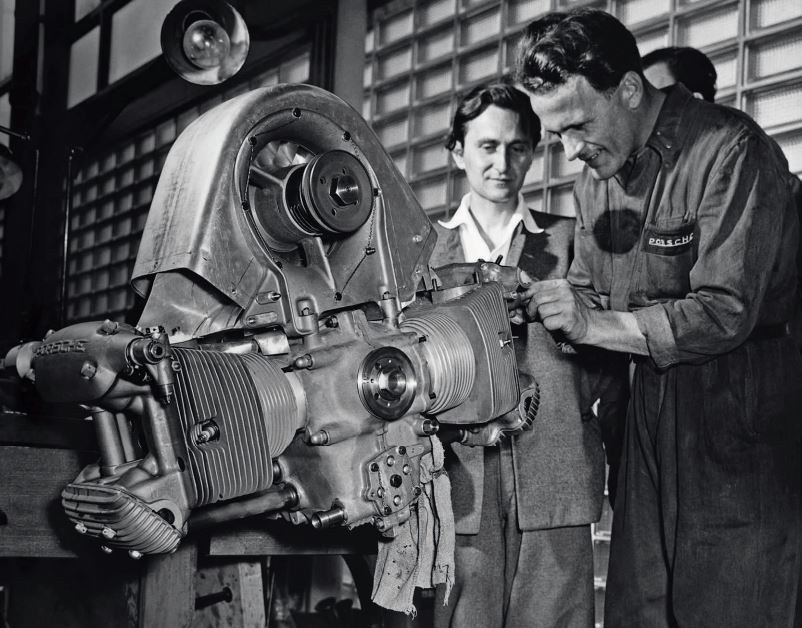
Observing the build of one of the four-cam Type 547 engines: Ernst Fuhrmann (L) and engineer Eberhard Storz.
And we digress. But why, you might ask, is the 547 engine so difficult? We found that Gordon Maltby summed it up most succinctly. “The elaborate cam drive on the 547 engine required proper adjustment of no less than six sets of bevel gears not to mention end-play for each shaft and correct bearing and valve clearances.”
As Roy states, “Much has, of course, been written about Porsche and the racing cars and engines created by the company. Many of the cars in this study have been looked at in passing, usually within a wider subject span, in the work of others.” We thought it a nice idea to go to the Porsche bookshelf to refresh our memory. And to be sure, SportErfolge (Success in Sport) by Tony Adriaensens, CorsaResearch; Porsche by Mailander, Karl Ludvigsen, Dalton Watson; Porsche 356 and RS Spyders by Gordon Maltby, MBI; Porsche Sports Racers, 1952-1968, Brooklands all cover the same time frame, each with a distinctive format. Could Smith justify another book covering the same era and make? Per Smith, “…this is the first time those early race cars and the performances that launched the integrity of the marque have all been brought together in one specific work and under one title.”
And even if one is a 33rd degree Porsche nut, there will be new photos and perhaps an Ah Ha minute or two.
The vast majority of the images in the book are from the Porsche Archives, where Roy is a welcome visitor, having written four previous books on the marque. We note that some were obtained from REVS, and are the work of the famous photographer Rodolpho Mailander. I found many of those evocative images of the early Porsche factory assembly area, and learned more about the working conditions, the coordination with the Reuter bodyworks, and the reason why only the first few Gmund coupes were aluminum. The fact that they were so light meant that the early coupes had a long racing life; I recall seeing one at Road America in 1960. One of a number of Ah Ha moments.
PORSCHE SILVER STEEDS, PORSCHE RACING, A DEDICATION 1948-1965 – STANDARD EDITION
By Roy Smith
This standard edition comprises 500 copies, numbered 1 – 500.
Measuring 330mm x 290mm, the book is quarter bound in Ratchford Heritage Flame and bright white Heritage Buckram, debossed on the front with a printed graphic depiction of cogs. It is encased in a Platinum Buckram bound slipcase, lined with pivoine red suedel with silver blocking to the spine.
First 150 copies £500
Next 150 copies £600
Next 150 copies £700
Final 50 copies £800
Order here:
www.palawan.co.uk
More images from the book:
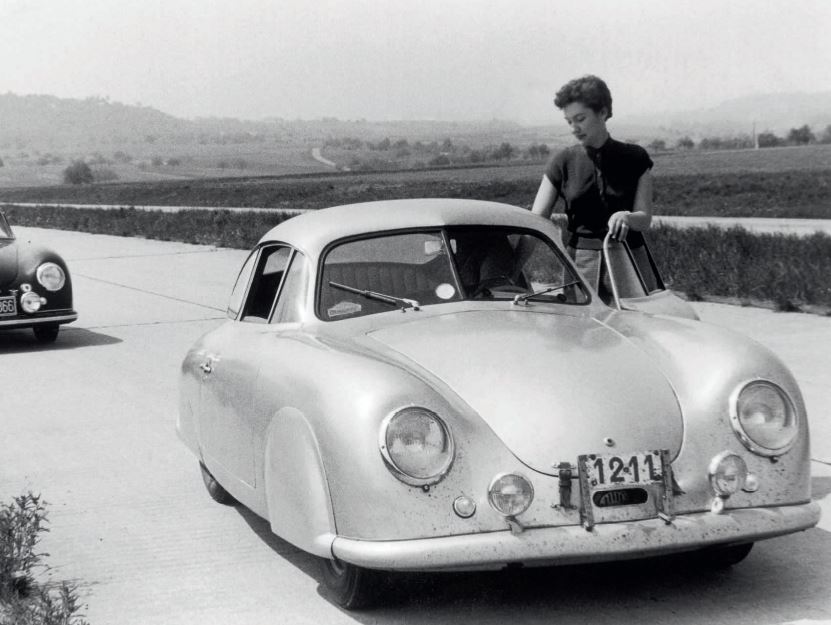
The very successful client car of Belgian driver Gilberte Thirion: the Gmünd Coupé 356 SL, former class winner at Le Mans. She also won her class on the Rallye Soleil-Cannes in 1952 with her father as co-driver.
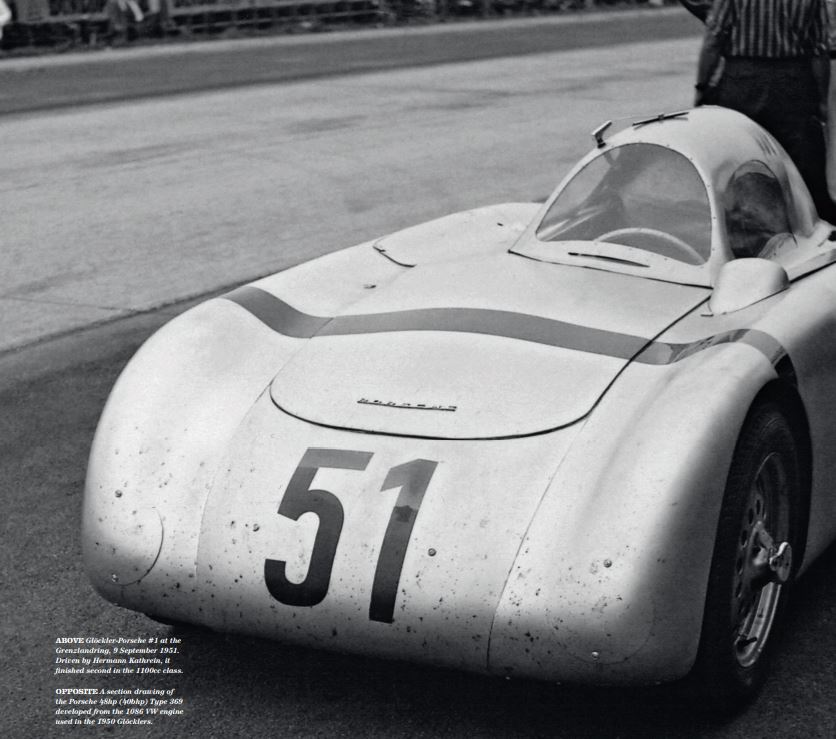
Glöckler-Porsche #1 at the Grenzlandring, 9 September 1951. Driven by Hermann Kathrein, it finished second in the 1100cc class.
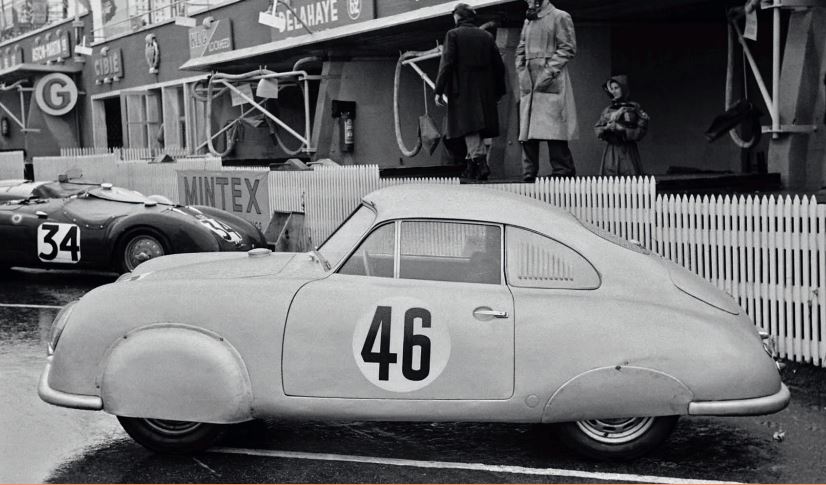
The first Porsche to run at the Le Mans 24 Hours. Three Reutter built
aluminum bodied cars had been made; two had been damaged during testing just before the week of Le Mans formalities. The best parts remaining from the two damaged cars were built into one, the 356SL #46. During practice for the race on 19 June the #47 car crashed and became hors de combat, leaving the car seen here, that of Edmond Mouche and Auguste Veuillet. (Revs/Mailander)

The 550 Le Mans coupé: a covered version was decided upon, for the advantage of making the car more aerodynamic on the long straights on the La Sarthe circuit.

Paris Salon 1953: top left, the ‘comfortised’ 550 displayed alongside the latest 356 coupé and cabriolet.

1954 Mille Miglia: Hans Herrmann and Herbert Linge’s 550-08 en route to sixth overall and a win in the sports 1500 class, bringing the first international victory for the four-cam engine. (Revs)
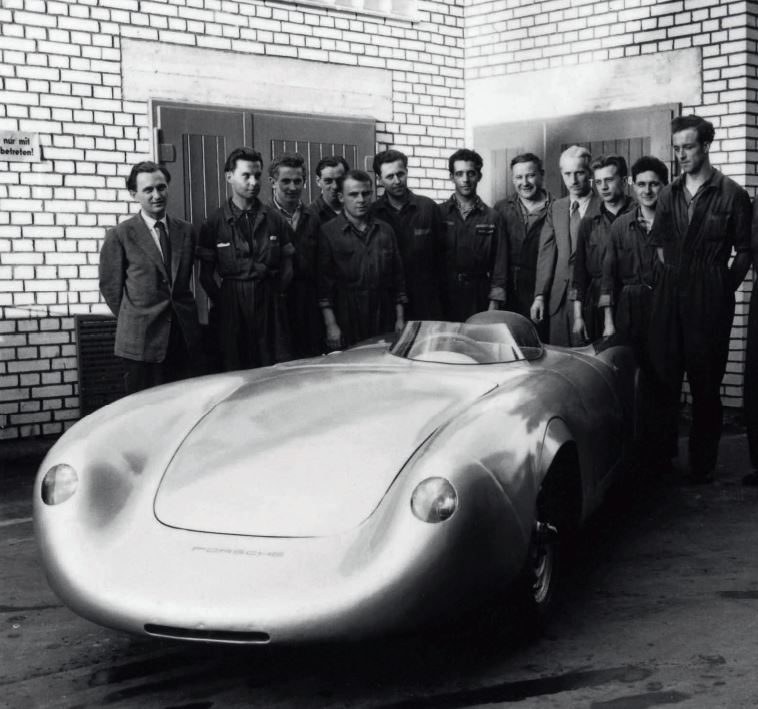
A special body for the 550-12 and von Frankenberg for the Avus race in 1954. On 19 September, Porsche employees stand behind the car; on the left, Ernst Fuhrmann; fifth from left Willi Enz; (next to Willi not known); Rolf Wütherich, Bruno Trostmann, Hubert Mimler; (next to Hubert not known); Ludwig Schmid, Eberhard Storz, far right is Egon Alber; centre in suit and tie, Wilhelm Hild.
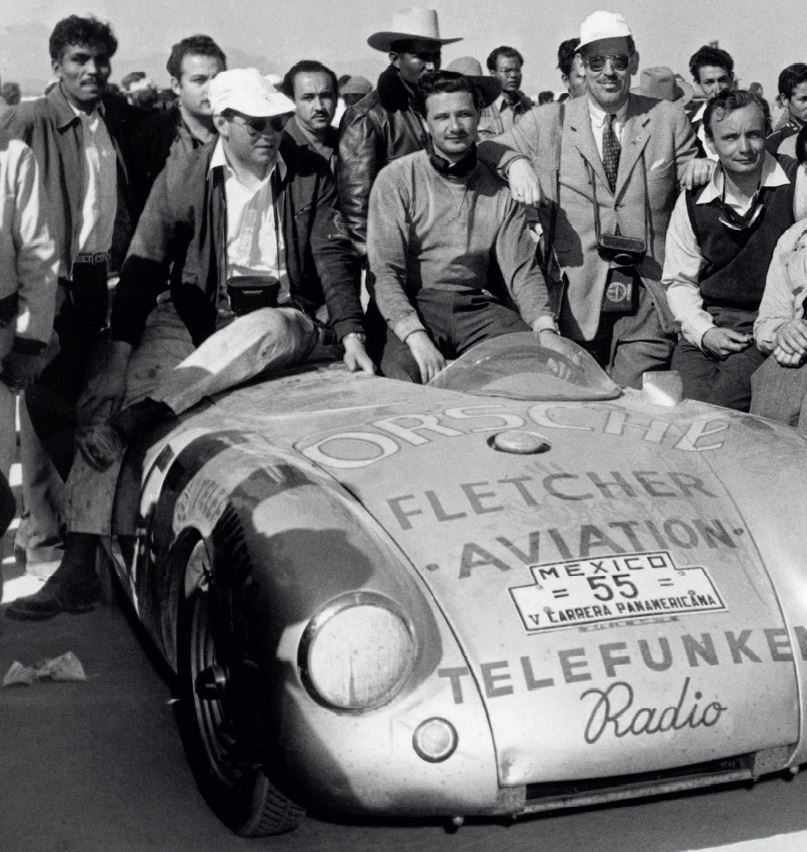
The famous group picture (at front, L–R) Herbert Linge, Hans Herrmann, Huschke von Hanstein and Jaroslav Juhan.
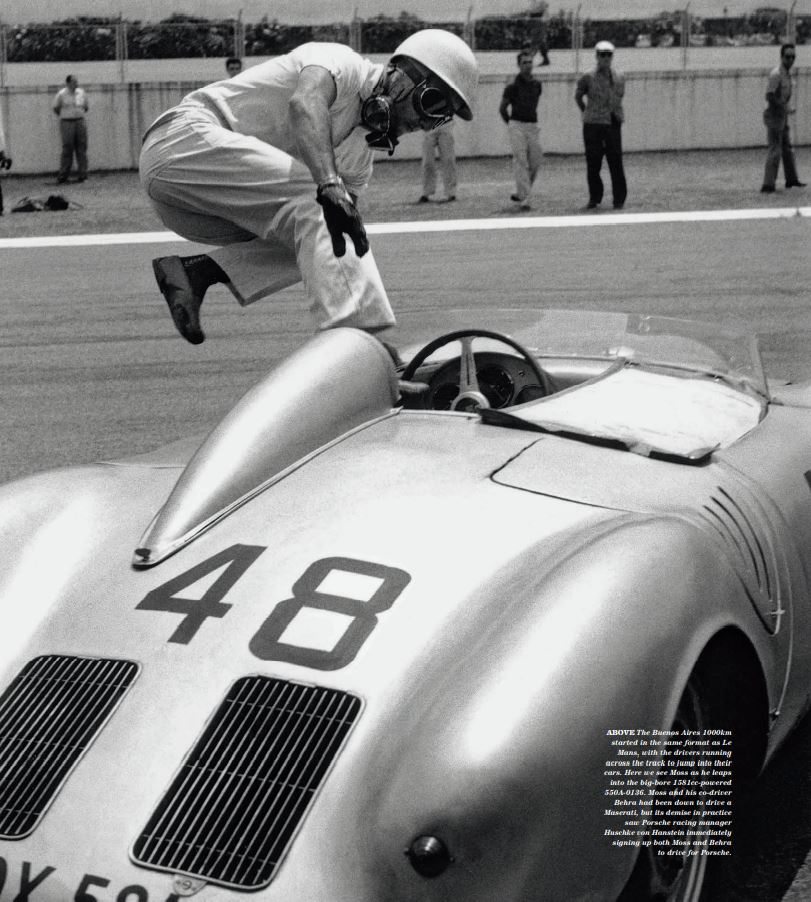
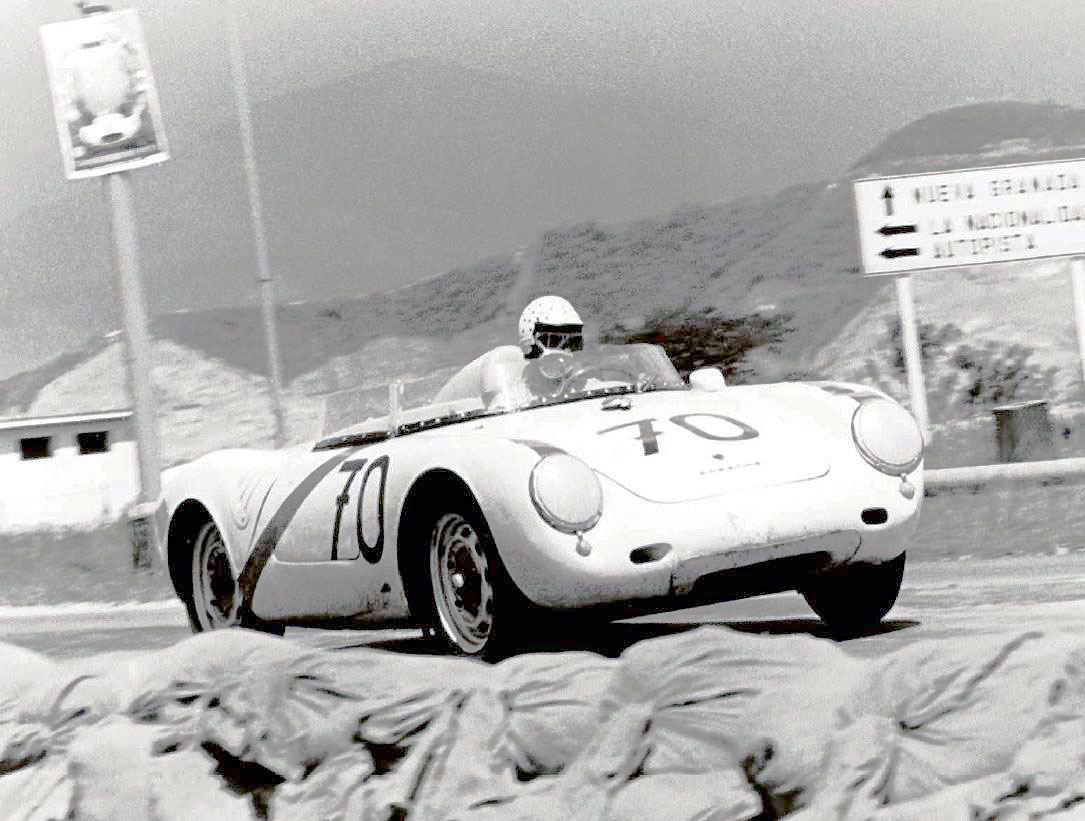
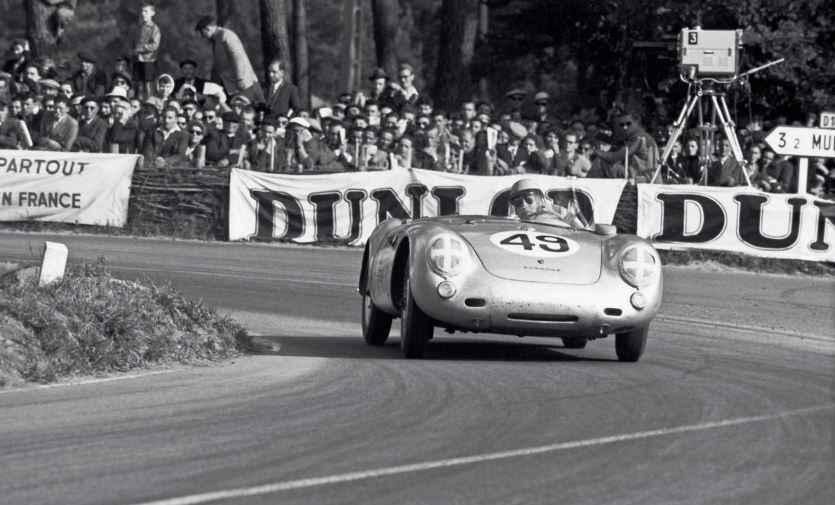
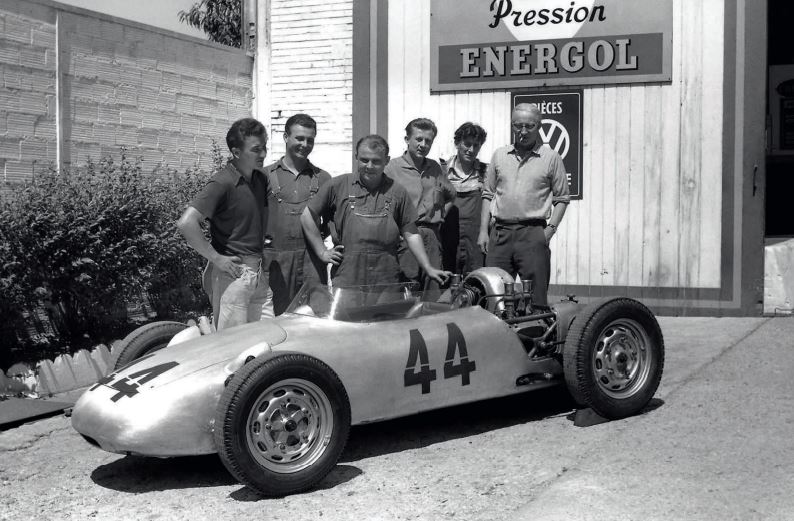
The “Giant Killers” is such an appropriate way to describe these wonderful masterpieces ! My late lifetime friend Joe Sheppard raced three different 550’s during his career. Thanks for your incredible work Mr Smith.
That’s very kind, thank you…….Roy Smith
Just a note that the images credited to Revs were taken by Rodolfo Mailander and are so identified in the Revs documentation. Rudy’s work deserves accreditation.